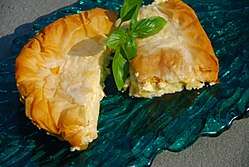Spanakopita
 Spanakopita | |
| Type | Savoury pie |
|---|---|
| Place of origin |
|
| Region or state | Asia Minor |
| Main ingredients | Phyllo, spinach (or leeks, chard, or sorrel), feta and/or ricotta, onions or scallions, eggs |
Spanakopita (/ˌspænəˈkɒpɪtə,
The traditional filling comprises chopped spinach, feta cheese, onions or scallions, egg, and seasoning.[1] The filling is wrapped or layered in phyllo (filo) pastry with butter or olive oil, either in a large pan from which individual servings are cut, or rolled into individual triangular servings. While the filo-dough recipe is most common, many recipes from the Greek islands call for a crust made of flour and water to form a crunchier, calzone-like exterior in place of the flaky filo dough. The pastry is golden in color when baked, the color often enhanced by butter and egg yolk. Other white, fresh, preferably salted cheeses may also be mixed with, or substituted for, the feta cheese.
It can be served straight from the oven or at room temperature. There is a "fasting", or vegan, version of spanakopita, eaten during the Great Lent and other religious fasts, and composed of spinach, onions or green onions, other green herbs like dill, parsley or celery, olive oil and a little wheat flour, but without eggs or dairy products; the mixture is oven-baked until crisp. Non-traditional vegan versions are available that typically use tofu instead of cheese.
In rural Greece, smaller amounts of spinach are used, with the missing amount replaced with leeks, chard and sorrel.
Spanakopita appears in many traditional Greek cookery books and appears in numerous restaurants and hotel menus throughout Greece and internationally. The pastry is similar to torta pasqualina, a traditional dish from Italy's Liguria region, that is very common in Argentina and Uruguay, and to pita zeljanica (sometimes considered a kind of burek) popular in Serbia and Bosnia. It is also a common dish in Gibraltar where cheddar or edam may replace the feta.
It can also be made with puff pastry.
